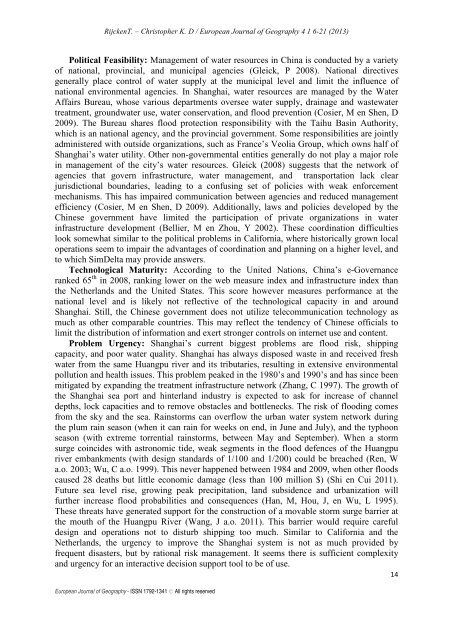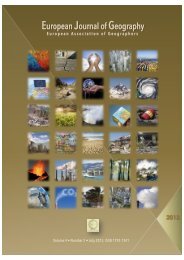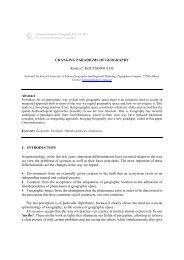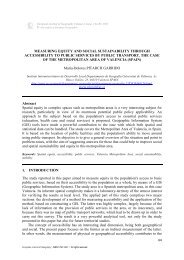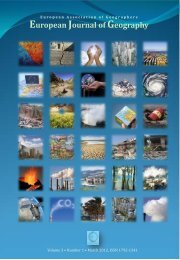European Journal of Geography
European Journal of Geography
European Journal of Geography
You also want an ePaper? Increase the reach of your titles
YUMPU automatically turns print PDFs into web optimized ePapers that Google loves.
RijckenT. – Christopher K. D / <strong>European</strong> <strong>Journal</strong> <strong>of</strong> <strong>Geography</strong> 4 1 6-21 (2013)<br />
Political Feasibility: Management <strong>of</strong> water resources in China is conducted by a variety<br />
<strong>of</strong> national, provincial, and municipal agencies (Gleick, P 2008). National directives<br />
generally place control <strong>of</strong> water supply at the municipal level and limit the influence <strong>of</strong><br />
national environmental agencies. In Shanghai, water resources are managed by the Water<br />
Affairs Bureau, whose various departments oversee water supply, drainage and wastewater<br />
treatment, groundwater use, water conservation, and flood prevention (Cosier, M en Shen, D<br />
2009). The Bureau shares flood protection responsibility with the Taihu Basin Authority,<br />
which is an national agency, and the provincial government. Some responsibilities are jointly<br />
administered with outside organizations, such as France’s Veolia Group, which owns half <strong>of</strong><br />
Shanghai’s water utility. Other non-governmental entities generally do not play a major role<br />
in management <strong>of</strong> the city’s water resources. Gleick (2008) suggests that the network <strong>of</strong><br />
agencies that govern infrastructure, water management, and transportation lack clear<br />
jurisdictional boundaries, leading to a confusing set <strong>of</strong> policies with weak enforcement<br />
mechanisms. This has impaired communication between agencies and reduced management<br />
efficiency (Cosier, M en Shen, D 2009). Additionally, laws and policies developed by the<br />
Chinese government have limited the participation <strong>of</strong> private organizations in water<br />
infrastructure development (Bellier, M en Zhou, Y 2002). These coordination difficulties<br />
look somewhat similar to the political problems in California, where historically grown local<br />
operations seem to impair the advantages <strong>of</strong> coordination and planning on a higher level, and<br />
to which SimDelta may provide answers.<br />
Technological Maturity: According to the United Nations, China’s e-Governance<br />
ranked 65 th in 2008, ranking lower on the web measure index and infrastructure index than<br />
the Netherlands and the United States. This score however measures performance at the<br />
national level and is likely not reflective <strong>of</strong> the technological capacity in and around<br />
Shanghai. Still, the Chinese government does not utilize telecommunication technology as<br />
much as other comparable countries. This may reflect the tendency <strong>of</strong> Chinese <strong>of</strong>ficials to<br />
limit the distribution <strong>of</strong> information and exert stronger controls on internet use and content.<br />
Problem Urgency: Shanghai’s current biggest problems are flood risk, shipping<br />
capacity, and poor water quality. Shanghai has always disposed waste in and received fresh<br />
water from the same Huangpu river and its tributaries, resulting in extensive environmental<br />
pollution and health issues. This problem peaked in the 1980’s and 1990’s and has since been<br />
mitigated by expanding the treatment infrastructure network (Zhang, C 1997). The growth <strong>of</strong><br />
the Shanghai sea port and hinterland industry is expected to ask for increase <strong>of</strong> channel<br />
depths, lock capacities and to remove obstacles and bottlenecks. The risk <strong>of</strong> flooding comes<br />
from the sky and the sea. Rainstorms can overflow the urban water system network during<br />
the plum rain season (when it can rain for weeks on end, in June and July), and the typhoon<br />
season (with extreme torrential rainstorms, between May and September). When a storm<br />
surge coincides with astronomic tide, weak segments in the flood defences <strong>of</strong> the Huangpu<br />
river embankments (with design standards <strong>of</strong> 1/100 and 1/200) could be breached (Ren, W<br />
a.o. 2003; Wu, C a.o. 1999). This never happened between 1984 and 2009, when other floods<br />
caused 28 deaths but little economic damage (less than 100 million $) (Shi en Cui 2011).<br />
Future sea level rise, growing peak precipitation, land subsidence and urbanization will<br />
further increase flood probabilities and consequences (Han, M, Hou, J, en Wu, L 1995).<br />
These threats have generated support for the construction <strong>of</strong> a movable storm surge barrier at<br />
the mouth <strong>of</strong> the Huangpu River (Wang, J a.o. 2011). This barrier would require careful<br />
design and operations not to disturb shipping too much. Similar to California and the<br />
Netherlands, the urgency to improve the Shanghai system is not as much provided by<br />
frequent disasters, but by rational risk management. It seems there is sufficient complexity<br />
and urgency for an interactive decision support tool to be <strong>of</strong> use.<br />
<strong>European</strong> <strong>Journal</strong> <strong>of</strong> <strong>Geography</strong> - ISSN 1792-1341 © All rights reserved<br />
14


